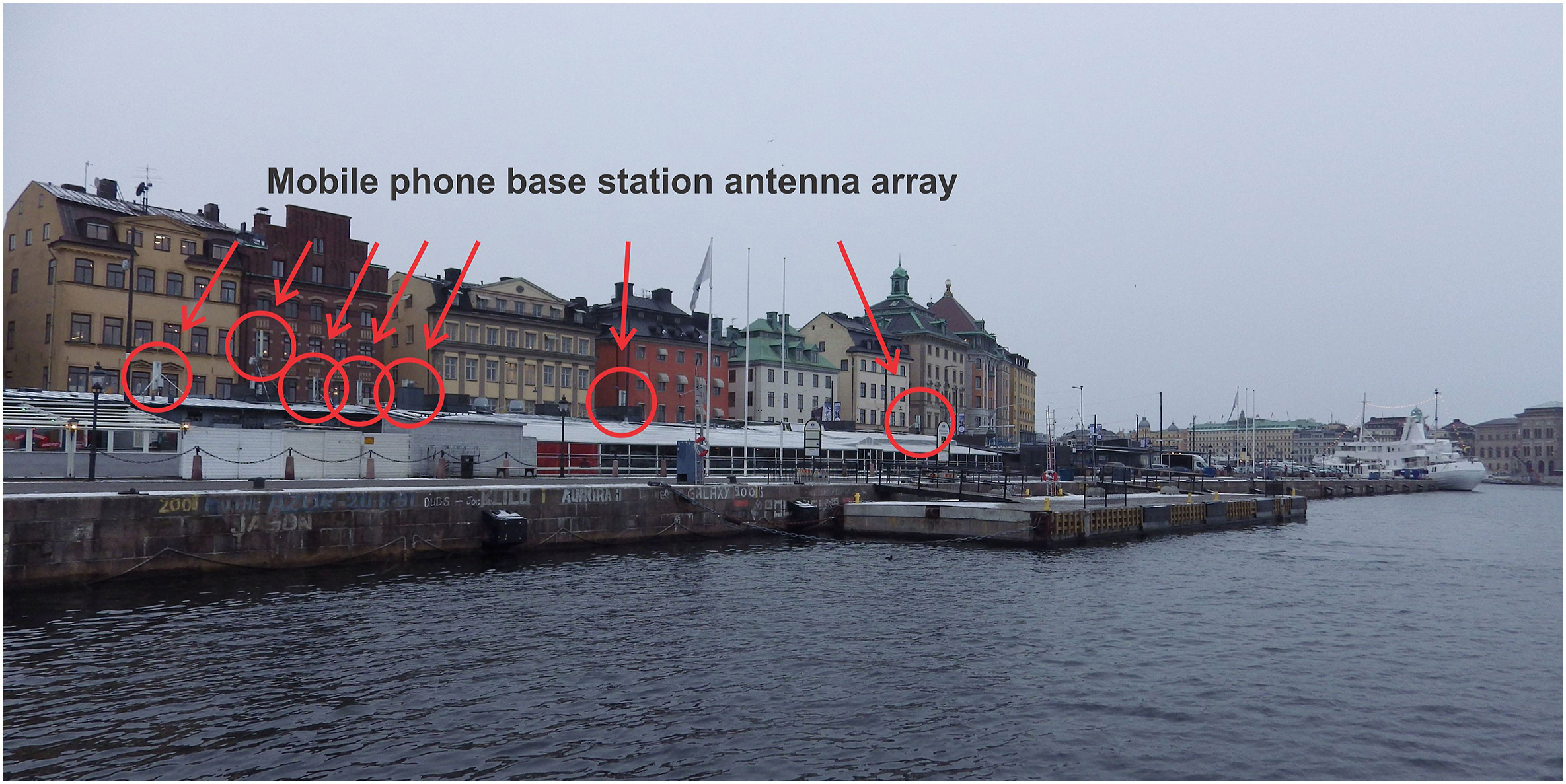
Poorly designed antenna structure at Stockholm
Seven low-level mobile phone antennas are located along the shore road in the Skeppsbron district of Stockholm (Sweden). An international team of researchers led by Mikko Ahonen from Finland and Michael Carlberg from Sweden concluded in a study that the determination of the locations along the shore road serves as an example of a poorly designed antenna structure. A portable exposimeter was used to record electromagnetic radiation at various measurement points. The highest average field strength in one of the defined segments was 12.1 volts per meter (V/m), corresponding to a radiation density of 388 milliwatts per square meter (mW/m²). The peak value in the area studied was 31.5 V/m (2,648 mW/m²), reaching over 50 percent of the internationally accepted limit of 61 V/m at a frequency of 2,600 megahertz.
Residents of nearby houses and employees in stores are particularly affected by the radio waves
The radio waves from the antennas, which are placed too low, radiate directly into the apartments next door and into the stores. The distances are a maximum of twenty to thirty meters. In 2004, the Naila study by Dr. Eger and colleagues had documented increased cancer rates in the vicinity of cell phone antennas. Similar results were obtained in the much larger study of Belo Horizonte (Brazil) between 1996 and 2006. Cancer-related mortality rates were also elevated in the vicinity of cell phone towers. In Belo Horizonte, a maximum of 12.4 volts per meter was measured. The lowest value was 0.4 volts per meter. At the time of data collection, the only transmission technology available was GSM (Global System Mobile), which occupies the 900 megahertz or 1800 megahertz frequency band. In the Skeppsbron study mentioned above, the highest radiation power came from LTE antennas in the frequency range of 2,600 megahertz.
Demand for compliance with precautionary values for mobile phone radiation
The authors of the Skeppsbron study refer in their demand for compliance with precautionary values to the results of the rat study of the Ramazzini Institute in Italy. The male rats developed malignant schwannomas in the heart (note: schwannomas are supporting and sheathing cells of the nerve fibers) during whole-body irradiation with a field strength of 50 volts per meter. Most guideline values in the environmental field have at least a safety threshold before the danger level of a factor of ten. If this factor were applied to the limit value of 61 volts per meter, the mobile phone antennas would only be allowed to emit a power of 6.1 V/m and would therefore not be permitted in the vicinity of the Stockholm waterfront.
In Germany, “small cells” cause high field strengths in city centers
The Telekom telephone pillars with a wired handset in the city centers do not show that they contain a powerful mobile transmitter with LTE technology. Only a label with the designation “Hotspot” gives the corresponding indication. The measured radiation density at a distance of fifty centimeters from the transmitting antenna yielded a result of 500 milliwatts per square meter (13.7 volts per meter) at a location in Bayreuth. The result corresponds to 23% of the legal limit in the frequency spectrum of 2,600 megahertz. With a precautionary value of 6.1 V/m, these systems would not be allowed to operate. For comparison, in average apartments without WLAN routers, a maximum limit value of 1% to 2% is found.
picture source: https://ars.els-cdn.com/content/image/1-s2.0-S0013935121019289-gr5.jpg
Further information on the Skeppsbron-study:
https://www.sciencedirect.com/science/article/pii/S0013935121019289
